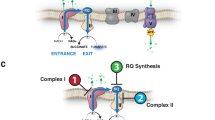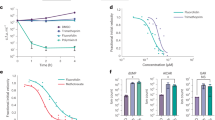Abstract
THE emergence in widely separated areas of strains of Plasmodium falciparum resistant to standard prophylaxis or therapy with chloroquine and related 4-amino-quinoline derivatives1–3 has led to a renewal of interest in the possible mechanisms of drug resistance in protozoa. Schueler and Cantrell4 and Cohen, Phifer and Yielding5 have recently proposed, on the basis of experiments with the rodent malaria parasite, P. berghei, that hæmatinic acid, which they state is an intermediary product formed during the metabolism of hæmoglobin to hæmatin, might be liberated in excess by certain parasite strains, that this porphyrin might form an insoluble complex with chloroquine and related drugs and that this could be a basis for the development by such parasites of tolerance towards certain chemotherapeutic agents. Hæmatin is known to be combined with a nitrogenous (peptide?) moiety to form the insoluble malaria pigment, hæmozoin6. Support for this hypothesis would be provided therefore by the demonstration that the quantity of the end product of hæmoglobin metabolism, hæmozoin, is decreased in those parasite strains which are able to liberate the soluble intermediary product, hæmatinic acid. In other words, there should be an inverse relationship between pigment formation and chloroquine resistance.
This is a preview of subscription content, access via your institution
Access options
Subscribe to this journal
Receive 51 print issues and online access
$199.00 per year
only $3.90 per issue
Buy this article
- Purchase on Springer Link
- Instant access to full article PDF
Prices may be subject to local taxes which are calculated during checkout
Similar content being viewed by others
References
Moore, D. V., and Lanier, J. E., Amer. J. Trop. Med. and Hyg., 10, 5 (1961).
Harinasuta, T., Migasen, S., and Boonnag, D., in First Regional Symp. Scientific Knowledge of Tropical Parasites, 148 (Unesco, Singapore, 1962).
Alving, A. S., in Drugs, Parasites and Hosts, 112 (Churchill, London, 1962).
Schueler, F. W., and Cantrell, W. F., J. Pharmacol. and Exp. Therap., 143, 278 (1964).
Cohen, S. N., Phifer, K. O., and Yielding, K. L., Nature, 202, 805 (1964).
Deegan, T., and Maegraith, B. G., Ann. Trop. Med. Parasit., 50, 194 (1956).
Field, J. W., and Shute, P. G., in The Microscopic Diagnosis of Human Malaria. II—A Morphological Study of the Erythrocytic Parasites, 120 (Government Printer, Kuala Lumpur, 1956).
Thurston, J. P., Trans. Roy. Soc. Trop. Med. and Hyg., 44, 703 (1951).
Author information
Authors and Affiliations
Rights and permissions
About this article
Cite this article
PETERS, W. Pigment Formation and Nuclear Division in Chloroquine-resistant Malaria Parasites (Plasmodium berghei, Vincke and Lips, 1948). Nature 203, 1290–1291 (1964). https://doi.org/10.1038/2031290a0
Published:
Issue Date:
DOI: https://doi.org/10.1038/2031290a0
This article is cited by
-
Hemozoin Biocrystallization in Plasmodium falciparum and the antimalarial activity of crystallization inhibitors
Parasitology Research (2007)
-
Morphological Effects of Chloroquine on Plasmodium berghei in Mice
Nature (1967)
-
Chloroquine Resistance and the Nature of Malarial Pigment
Nature (1965)
-
Mepacrine- and Primaquine-resistant Strains of Plasmodium berghei, Vincke and Lips, 1948
Nature (1965)
Comments
By submitting a comment you agree to abide by our Terms and Community Guidelines. If you find something abusive or that does not comply with our terms or guidelines please flag it as inappropriate.



